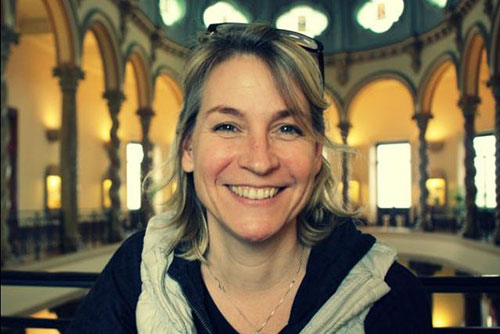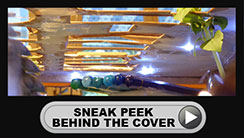Below you will find a selection of the most recent entries from bloggers in the Your Home section.
To view the entries from individual bloggers, click on the links below:
Anna Lascols, Organizing Geneva
Her mission as a professional organizer is to improve people’s lives by coaching them how to set up and maintain efficient systems to keep their time and space in order. Anna helps her clients to visualize their ideal lifestyle and works side-by-side with tem to reach their goals. These can range from redesigning their closet à la Marie Kondo to getting their paperwork under control, improving their time management skills or preparing for the arrival of a baby. Anna is a KonMari Consultant and a member of the Swiss Association of Professional Organizers (Swiss-APO). She works in and around Geneva and provides her services is English, French, German and Spanish. She offers personal organizing sessions, virtual coaching and organizes workshops on various organizing and zero waste topics.
Liz Forest - EMF Management
Liz Forest is the founder and owner of EMF Management, a Swiss-registered renovation project management company servicing the international community in the greater Lake Geneva / Vaud region. EMF handles the heavy lifting so clients do not have to learn a new trade, take time off work, or sacrifice family holidays or their sanity just to make their house a home.
Virginie Dor - Space of Mine
As founder of Space of Mine, a professional business specializing in residential organizing, Virginie Dor is committed to helping individuals and families better their lives, take control of their surroundings and time by creating organizing solutions that are individually tailored to each client. As a proud member of NAPO (National Association of Professional Organizers), she is an expert in clutter control, work flow, space planning and time management.
Tara Lissner - Swiss Gardening School
An enthusiastic, self-taught gardener, Tara Lissner is passionate about gardening and eager to share her zeal and knowledge with other gardening fans. In 2012, she joined forces with Hester Macdonald, a British-trained landscape designer, to launch the Swiss Gardening School.
Aislinn Delmotte - Settling Here
Aislinn Delmotte runs Settling Here, a company which aims to provide practical help and advice to individuals, couples and families relocating to the Pays de Gex, a region where some of the customs are similar to those in neighbouring Switzerland, but where many aspects of living are entirely different.
Sophia Kelly - Sophia Kelly Home Design
Responding to the growing demand for home design services in the international community, Sophia Kelly provides a range of tailor-made services, which are perfect for clients who have just moved into a new home or who simply need help reorganizing one that they have lived in for many years!

by Gareth Jefferies, Alpine Property
I don't suppose living in the Alps is that great from an Ecological perspective. Though as time goes on we are learning (actually, being slowly forced) to reduce our carbon footprint on the environment. Not many people think about this though, even with the government's attempts to help (see the DPE labels). I've written about it in the past too (An Eco-Chalet in the Alps). Despite this I did have a customer say to me recently "I'm only interested in building a new place...for eco reasons", maybe as time goes on it will happen more often? Though I'm not sure that building from scratch is that eco-friendly, despite the fact the heating bills will be less. The carbon footprint from the new materials might well outweigh the long-term benefits.
I've been living in my house for 14 years and have only got around to upgrading the last remaining single glazed windows this winter. It's never been a priority for me as I'm well aware that the pay back won't happen for 20 or more years. I took the opportunity to take some infrared pictures to show the difference before and after. It was a bit of an eye opener. Not the difference the windows made but how much heat my house is giving off!
The first photo shows my house on a cold day (-7C), the ground floor is 60cm of solid (stone and rubble) construction with no insulation. The upstairs of my property was insulated when it was renovated 30 years ago. They use hollow bricks with a small amount of mineral wool insulation stuffed between them. There is no vapour barrier and externally the walls are wood clad. The shocking thing here is the walls are 10C. The single-glazed windows are obvious on the picture and are only slightly colder (15C) than the inside temperate at the time (19C).

By Aislinn Delmotte, Settling Here
“Raising Global and Mobile Kids” was the theme of an interactive seminar run by Settling Here in Feb 2017 at Webster University. The expert guest speaker was Kristin Duncombe, a Geneva based psychotherapist and author. The seminar looked specifically at international identity and mental-health, and Kristin spoke about raising children in an international context, and the impact of a global, mobile existence on identity and self-esteem.
The diverse audience included anglophone and francophone parents, who are raising children who are bi-cultural, bi-lingual and also third culture children. It’s not always easy to categorize one’s family and its culture but I liked Kristin’s presented definition of third culture which breaks down into three: namely the culture(s) of the family, the culture of the host country (ies), the expatriate subculture and/or the bi-cultural families subculture. There are a lot of cultures at play for some of our Global kids and the critical tasks for parents are to help their kids understand their culture(s) of origin, help them get along in mainstream society and also deal with being a "hidden immigrant".

By Tara Lissner, Swiss Gardening School
Well we’ve been on a roller coaster with the weather over the past few weeks. The Indian summer lasted beautifully through the end of September and with the arrival of October the temperatures dropped and the bise wind rose. The tomatoes hung on to the bitter end but it is all over, the green ones are now in the kitchen in the hope that they may turn red but I predict an afternoon of green chutney making in my future.
This time of year is always bittersweet for the gardener, the glory of the summer garden has come to an end, the perennials have all gone to seed and while the seed-heads look wonderful the colour is slowly disappearing before us. Dahlias continue to perform and until we have consecutive nights of freezing temperatures they will continue to shine. It is a time to think about the future of course because this is the perfect time to add plants to the garden, trees, shrubs, hedges and perennials can all be planted until the freezing temperatures arrive. Have you got plans for trees, adding perennials? Take advantage of dry days to get out and make plans and plant them up, it is never nice to garden in the rain.
I’ve been busy this week, harvesting all the beans, I’ll be drying them out, shelling and storing them for use in soups and stews over the winter. I aways cut the plants to the ground, throwing them onto the compost, and leave the roots alone until the spring, this allows the nitrogen nodules along the fine roots of the beans plants to augment the nitrogen in the soil. I then cover the bed with about a 10 cms layer of mulch and leave that to work its way into the soil over the winter. Home made compost makes for a great mulch but it should be well broken down and at least a year old. If you don’t have any ready to go there are a number of places locally where you can buy it by the “big-bag” or have it delivered. I’ve used BGS Compost SA in Givrins, although closed on Saturdays it opens from 07:00 Monday to Friday.

By Tara Lissner, Swiss Gardening School
It is true that most of us who garden spend a fair amount of time discussing the weather; too hot; too dry; too windy; too wet; too wet; too wet. Well this summer we’ve certainly had a lot to discuss, with the incredibly wet and cool start in May and June to the tremendous heat of August – never a dull moment. Our gardens are so quickly affected by the changing weather conditions especially when it is holiday time and we are not on hand to adapt our habits day-by-day or week-by-week. In my experience it is always best to err on the side of caution and this is a perfect example of why. Early this summer I left half a dozen newly purchased perennial geraniums amongst a group of larger pots hoping they would be happy (and sheltered) enough during my week-long absence – I came home to crisp leaves and parched soil. I was so sad I immediately moved them to a more shady spot, drenched them with water and have been nursing them back to their original state ever since. Note to self, always pay a teenager to water even for a short trip.
The hydrangeas this summer have been just spectacular and although they need quite a lot of water, if they are in the correct position in the garden they will have given you quite the show. There has been a renaissance of the hydrangea in recent years with more and more varieties becoming easily available, this year I found a very pretty new (to me) variety called Hydrangea arborescens “Incredible Pink”. As the name suggests it is pink but not the bright showy pink of my childhood. Each petal is delicately edged in pink giving an overall dusty pink colour (see photo above) – just gorgeous, now all I have to do is find a reasonably shady spot for it in my garden, no easy feat.

By Aislinn Delmotte, Settling Here
Are you driving in France on foreign license plates, with a foreign drivers license and insurance? If so, the question many expats ask is: Does a foreigner have to re- register his/her car in France with French plates?
According to the French government information website (https://www.service-public.fr/particuliers/vosdroits/F10519), the answer is a clear YES, and within a month of bringing the car here if you are a French resident.
What constitutes a French resident then? Basically it's somebody living here at least 8 months of the year. There are of course some exceptions to this status (aren't there always!).







